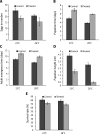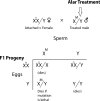Exploration of teratogenic and genotoxic effects of fruit ripening retardant Alar (Daminozide) on model organism Drosophila melanogaster
- PMID: 30181710
- PMCID: PMC6117819
- DOI: 10.2478/intox-2018-0004
Exploration of teratogenic and genotoxic effects of fruit ripening retardant Alar (Daminozide) on model organism Drosophila melanogaster
Abstract
Alar (Daminozide) is a plant growth regulator which is widely used as a fruit preservative for apple and mango to prevent pre-harvest fruit drop, promote color development and to delay excessive ripening. The aim of the present work was to demonstrate the effect of Alar on several life history traits, adult morphology, Hsp70 protein expression and in vivo DNA damage in the brain of the model organism Drosophila melanogaster. We assessed the life history and morphological traits including fecundity, developmental time, pupation height, egg-to-adult viability and mean wing length, body length, arista length and sternopleural bristle number of the emerging flies. The results showed a significant delay in the developmental milestones, increase in body length, wing length, arista length, a decrease in fecundity, pupal height and variation in sternopleural bristle number in the treated flies in comparison to the controls. Overexpression of Hsp70 protein suggests alar induced subcellular molecular stress and comet assay validates genotoxicity in the form of DNA damage in the treated larvae. Mutation screening experiment revealed induction of X lined lethal mutation.
Keywords: Alar; DNA damage; Hsp 70; comet assay; drosophila melanogaster; life history traits.
Figures









Similar articles
-
Genes regulating wing patterning in Drosophila melanogaster show reduced expression under exposure of Daminozide, the fruit ripening retardant.Environ Toxicol Pharmacol. 2020 Apr;75:103322. doi: 10.1016/j.etap.2019.103322. Epub 2019 Dec 20. Environ Toxicol Pharmacol. 2020. PMID: 31877500
-
Effects of plant growth retardant daminozide (Alar) on neuromuscular co-ordination behavior in Drosophila melanogaster.J Toxicol Environ Health A. 2022 Nov 17;85(22):921-936. doi: 10.1080/15287394.2022.2114564. Epub 2022 Aug 22. J Toxicol Environ Health A. 2022. PMID: 35996764
-
Fruit ripening retardant Daminozide induces cognitive impairment, cell specific neurotoxicity, and genotoxicity in Drosophila melanogaster.Neurotoxicology. 2024 Jul;103:123-133. doi: 10.1016/j.neuro.2024.06.002. Epub 2024 Jun 6. Neurotoxicology. 2024. PMID: 38851594
-
Comparative analysis of morphological traits among Drosophila melanogaster and D. simulans: genetic variability, clines and phenotypic plasticity.Genetica. 2004 Mar;120(1-3):165-79. doi: 10.1023/b:gene.0000017639.62427.8b. Genetica. 2004. PMID: 15088656 Review.
-
The nature of quantitative genetic variation revisited: lessons from Drosophila bristles.Bioessays. 1996 Feb;18(2):113-21. doi: 10.1002/bies.950180207. Bioessays. 1996. PMID: 8851044 Review.
References
-
- Ashburner M. Drosophila: a laboratory manual. New York, USA: CSHLPress; 1989.
-
- Casares P, Carracedo MC, Garcia-Florez L. Analysis of larval behaviours underlying the pupation height phenotype in Drosophila simulans and D melanogaster. Genet Sel Evol. 1997;29(6):589–600.
-
- Chang CJ, Gill MK, Liu S, Mang SL, Yung E. The effect of temperature on development time and body size in male and female wild-type Oregon-R and mutant ort-1 Drosophila melanogaster. The Expedition. 2014;4
-
- Chen SY, Leask KP, MacKinnon SW, Ramanaden YJ, Yoon JH. The effects of temperature on the time to maturation of Drosophila melanogaster. The Expedition. 2013;3
-
- Dad I, Yousuf MJ, Anjum SI. Determination of LC50 of Chlorpyrifos and Neem extract on third instar larvae of house flies and their effect on fecundity. J Basic ApplSci. 2011;7(2):169–174.
LinkOut - more resources
Full Text Sources
Other Literature Sources
Molecular Biology Databases
